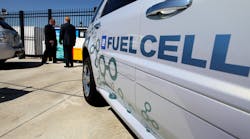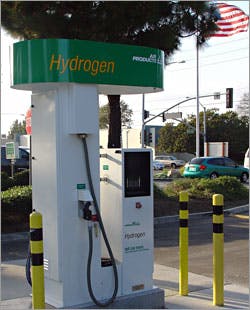The Energy Department’s National Renewable Energy Laboratory (NREL) opened its new hydrogen fueling station in Golden, Colorado on October 8 to coincide with National Hydrogen and Fuel Cell Day. This particular date was chosen since its numerical representation matches hydrogen’s atomic mass of 1.008 amu.
The 700-bar hydrogen fueling station will function as a compression, storage, and dispensing (CSD) unit for powering fuel-cell commercial vehicles. It functions as a retail-style station with a focus on research for hydrogen infrastructure and fuel cell vehicles. Fuel cells located about 100 km away from the fueling center produce hydrogen via electrolysis, which is then fed through a gas transmission pipeline to the station.
The station is an addition to NREL’s Hydrogen Infrastructure Testing and Research Facility (HITRF), and part of the NREL’s technology validation effort. HITRF scientists will continue to test new fuel-cell technologies, and develop greenhouse-gas-reducing methods for electrolysis in hydrogen production.
The first hydrogen fueling station in Colorodo opened in 2009 at the National Wind Technology Center just south of Boulder. The Wind-to-Hydrogen project aims at developing sustainable electrolysis methods to produce hydrogen as an automotive fuel source. The project is one of many that focuses on maintaining electrolysis despite the intermittence of many renewable resources.
In 2014, the NREL released a report that addresses the progress, current costs, and outlook of the 700-bar hydrogen refueling facilities. As part of its mission, the NREL will further research ways to integrate renewable resources into the grid for electrolysis and fuel cells. The aim is to generate hydrogen without the need for greenhouse-gas-emitting energy sources.

